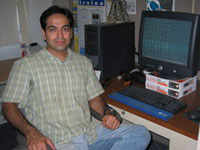Contact Information
Architectures & Compilers for Embedded Systems
dutt@uci.edu
(949) 824-7219
https://www.ics.uci.edu/~dutt/
Professor Dutt’s Research
Visit Web Site
Research Interests
- Architectures and Compilers for Embedded Systems
- Memory architecture exploration for Systems-on-Chip
- System specification techniques
- Software/Hardware synthesis, analysis and verification
- Architectural exploration for SOC and domain-specific problems
- Low-power/low-energy analysis and design techniques
- Hardware/software interfaces for distributed embedded systems
- Electronic Design Automation
- Brain-inspired computing and architectures
Current NSF Projects
- Variability Expedition: Variability-Aware Software for Efficient Nanoscale Devices
- CYPRESS: CYber-Physical RESilience & Sustainability
Other Active UCI Projects:
- Spiking Neural Networks: with Jeff Krichmar (CARL Lab) in Cognitive Sciences
- Ultimately Reliable and Safe (Zero-Recall) Software Technology Development: with Sung-Soo Lim, Kookmin University, Korea
Selected Projects
SoC Communication Design Space Exploration (COMMEX)
 Key Researcher: Sudeep Pasricha
Key Researcher: Sudeep Pasricha
Web Site: https://www.cecs.uci.edu/~aces/
Modern Systems-on-Chip are increasingly becoming more and more complex. Communication between on-chip components frequently becomes a bottleneck due to the numerous inter-component data dependencies inherent in these complex systems. Designers need to explore communication architectures to meet system performance requirements and satisfy the ever shrinking time-to-market constraints. Our main focus is on developing a methodology for modeling SoC designs for early exploration, power/performance tradeoff analysis and synthesis of the communication architectures in modern SoC designs.
download pdf S. Pasricha, N. Dutt, M. Ben-Romdhane, “Extending the Transaction Level Modeling Approach for Fast Communication Architecture Exploration”, DAC 2004, San Diego, CA, June 2004.
download pdf S. Pasricha, N. Dutt, “COSMECA: Application Specific Co-Synthesis of Memory and Communication Architectures for MPSoC”, Design Automation and Test in Europe Conference, Munich, Germany, March 2006.
dowload pdf S. Pasricha, N. Dutt, M. Ben-Romdhane, “Constraint-Driven Bus Matrix Synthesis for MPSoC”, Asia and South Pacific Design Automation Conference, Yokohama, Japan, January 2006.
(Best Paper Award)
download pdfS. Pasricha, N. Dutt, E. Bozorgzadeh, and M. Ben-Romdhane, “Floorplan-aware Automated Synthesis of Bus-based Communication Architectures”, Design and Automation Conference, Anaheim, CA, June 2005.
(Best Paper Award Candidate)
download pdf
Memory subsystem optimizations and customizations for embedded applications (FORAY-GEN)
 Key researchers: Ilya Issenin
Key researchers: Ilya Issenin
Web Site: https://www.cecs.uci.edu/~aces/
The memory subsystem consumes a large percentage of overall energy in many modern embedded systems. In our research we are investigating different configurations of non-traditional memory hierarchies that use components such as multiple custom scratch pad based memories, and tradeoffs between local and global memory organizations in the context of complex multiprocessor SOCs, with the overall goals of reducing energy consumption and improving performance of embedded applications.
Reference: I. Issenin, E. Brockmeyer, M. Miranda, N. Dutt, “Data Reuse Analysis Technique for Software-Controlled Memory Hierarchies”, DATE 2004, Paris, France, February, 2004.download pdf
Power Estimation of Low-Power High-Performance Memory Structures (IDAP/eCACTI)
 Key researchers: Mahesh Mamdipaka
Key researchers: Mahesh Mamdipaka
Web Site: https://www.cecs.uci.edu/~aces/
This project investigates power modeling of custom memory structures at different levels of abstraction. With increasing memory content in systems, their percentage contribution to total power dissipation is predicted to further increase in future technologies. We have developed a generic methodology and models for estimation of power dissipation in array structures at different levels of the design hierarchy. At the transistor level, we developed a generic methodology to generate characterization based analytical power models for array structures. At the Register Transfer level (RT level), we developed an estimation tool named Implementation Dependent Array Power estimator (IDAP) that estimates power dissipation based on a high-level design description of the memory arrays. IDAP estimates both leakage and dynamic power dissipation in array structures. Finally, at the micro-architecture level, we developed eCACTI (enhanced CACTI), a tool that (a) estimates the power dissipation in caches, and (b) determines the optimal cache configuration that best meets the optimization criterion.
Reference: M. Mamidipaka, K. Khouri, N. Dutt, M. Abadir, “IDAP: A Tool for High Level Power Estimation of Custom Array Structures “, IEEE Transactions on CAD (TCAD), Sept. 2004.download pdfM. Mamidipaka, K. Khouri, N. Dutt, M. Abadir, “Analytical Models for Leakage Power Estimation of Memory Array Structures”, Proc. of Int’l Conference on Hardware/Software and Co-design and System Synthesis (CODES+ISSS), Stockholm, Sweden, Sep 2004.
download pdf
Generation of High-Quality Instruction Set Extensions (ISEGEN)
 Key researchers: Partha Biswas
Key researchers: Partha Biswas
Web Site: https://www.cecs.uci.edu/~aces/
Customization of processor architectures through Instruction Set Extensions (ISEs) is an effective way to meet the growing performance demands of embedded applications. A high-quality ISE generation approach needs to obtain results close to those obtained by experienced designers, particularly for complex applications that exhibit regularity: expert designers are able to exploit manually such regularity in the data flow graphs to generate high-quality ISEs. Our ISEGEN approach identifies high-quality ISEs by iterative improvement following the basic principles of the well-known Kernighan-Lin (K-L) min-cut heuristic. Experimental results on a number of MediaBench, EEMBC and cryptographic applications show that our approach matches the quality of the optimal solution obtained by exhaustive search. We also show that our ISEGEN technique is on average 20X faster than a genetic formulation that generates equivalent solutions. Furthermore, the ISEs generated by our technique exhibit 35% more speedup than the genetic solution on a large cryptographic application (AES) by effectively exploiting its regular structure.
Reference: P. Biswas, S. Banerjee, N. Dutt, L. Pozzi and P. Ienne, “Fast Automated Generation of High-Quality Instruction Set Extensions for Processor Customization”, Workshop on Application Specific Processors (WASP), 2004.P. Biswas, V. Choudhary, K. Atasu, L. Pozzi, P. Ienne and N. Dutt, “Introduction of Local Memory Elements in Instruction Set Extensions”, Design Automation Conference (DAC), 2004.Power Aware Error Resilient Coding
 Key researchers: Minyoung Kim, Hyunok Oh
Web Site: https://www.cecs.uci.edu/~aces/
Key researchers: Minyoung Kim, Hyunok Oh
Web Site: https://www.cecs.uci.edu/~aces/
With advance in technology and the trend towards “convergent mobile computing”, there will be growing demand for high quality mobile multimedia communication. This problem should be solved with reasonable compression efficiency, coupled with high error resiliency, which is a crucial factor for the real-time multimedia communication over lossy networks. Specifically, in the mobile handheld environment, this problem is also linked with the consideration of the innate limitation of the handheld devices, such as the short battery lifetime and the low CPU computation capability. Therefore, in this project, we introduce a new power aware error resilient encoding scheme that can run at various operating points in accordance with resource constraints. This research is a part of FORGE project: a Framework for Optimization of Distributed Embedded Systems Software.
Reference: Radu Cornea, Nikil Dutt, Rajesh Gupta, Ingolf Krueger, Alex Nicolau, Doug Schmidt, Sandeep Shukla, “FORGE: A Framework for Optimization of Distributed Embedded Systems Software”, International Parallel and Distributed Processing Symposium, April 2003.Architecture Aware Compilation for Embedded Systems
 Key researchers: Aviral Shrivastava
Web Site: https://www.cecs.uci.edu/~aces/
Key researchers: Aviral Shrivastava
Web Site: https://www.cecs.uci.edu/~aces/
Modern embedded processors are incorporating several dynamic schemes (e.g. dynamic scheduling, caches, predication) to meet the ever tightening, multi-dimensional demands of embedded applications. However the complex and dynamic nature of these architectural and micro-architectural techniques renders them intractable for exploitation by conventional compiler technology. Our research attempts to model and exploit these dynamic mechanisms within such processors during the process of code generation. We investigate compilation strategies for performance, power and code size, while allowing for exploration and evaluation of different micro-architectural features.
Reference: A. Shrivastava, N. Dutt “Energy Efficient Code Generation using rISA”, ASPDAC’ 2004.download pdf
Task-level partitioning and scheduling for reconfigurable systems
 Key researchers: Sudarshan Banerjee
Web Site: https://www.cecs.uci.edu/~aces/
Key researchers: Sudarshan Banerjee
Web Site: https://www.cecs.uci.edu/~aces/
Hardware-Software (HW-SW) partitioning is a critical step in codesign of embedded systems- key system parameters such as execution time, power consumption etc., are primarily influenced by partitioning decisions. SRAM-based FPGAs are becoming popular for HW implementation and design sizes are increasing very rapidly. In this context, there is a need to investigate efficient and scalable partitioning and scheduling algorithms that do a very rapid and high-quality exploration of the design space. One key feature of modern FPGAs is dynamic reconfiguration where the hardware configuration can be changed dynamically to obtain better performance at lower hardware cost. While this is a very powerful feature, it introduces a lot of architectural constraints on the system. We are developing a number of partitioning and scheduling algorithms to generate high-quality results in the context of multiprocessor SOCs.
Reference: S. Banerjee, N. Dutt, “Efficient Search Space Exploration for HW-SW Partitioning”, CODES+ISSS, Stockholm, 2004.Distributed Real-time Embedded Analysis Method
 Key researchers: Gabor Madl
Web Site: http://dre.sourceforge.net
Key researchers: Gabor Madl
Web Site: http://dre.sourceforge.net
Real-time middleware provides dependable and efficient platforms supporting key functional and quality of service (QoS) needs of distributed real-time embedded (DRE) systems. Key challenges in DRE system developments include safe composition of system components and mapping the functional specifications onto the target platform. Model-based technologies help address these issues by enabling design-time analysis and providing the means for the rapid evaluation of design alternatives with respect to end-to-end QoS properties, predictability and performance measures before committing to a specific platform. The Distributed Real-time Embedded Analysis Method DREAM T is an open-source tool and method for optimizing multiple quality of service (QoS) properties of distributed real-time embedded (DRE) systems. The project focuses on the practical application of formal analysis methods to real-time middleware to automate the verification, development, configuration, and integration of middleware-based DRE systems.
Reference: G. Madl, S. Abdelwahed, D. C. Schmidt, “Verifying Distributed Real-time Properties of Embedded Systems via Graph Transformations and Model Checking”, Real-Time Systems, Special Issue: Invited Papers from the 25th IEEE International Real-Time Systems Symposium, Volume 33, Numbers 1-3, pages 77-100, July 2006.G. Madl, S. Pasricha, Q. Zhu, L. Angel D. Bathen, N. Dutt, “Formal Performance Evaluation of AMBA-based System-on-Chip Designs”, Proceedings of EMSOFT 2006.download pdf

